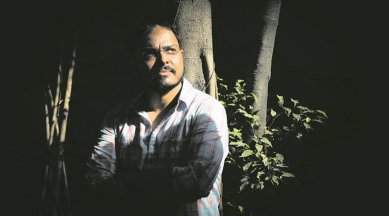We wanted to talk to upper-caste youth about caste, says co-writer of Article 15
Writer Gaurav Solanki on Article 15, caste discrimination, and the hope of starting a conversation.

Growing up in the small town of Sangaria in northern Rajasthan, Gaurav Solanki saw caste discrimination from a position of privilege. “In my village, if the person cleaning the drains in the street would ask for drinking water from a house, people would offer a jug from a safe distance. A glass would never be offered. Once, I saw an uncle of mine rough up a ‘lower-caste’ safai karamchari in the village. I was about 12,” says Solanki, 33. It was a perspective he tapped into while writing the dialogues and script of Article 15, which he co-wrote with director Anubhav Sinha.
The film focuses on Article 15 of the Indian Constitution, which prohibits discrimination on grounds of religion, race, caste, sex or place of birth. Structured as a crime-thriller, it references real-life incidents — the gangrape in Badaun of two girls (2014) and the flogging of a Dalit family in Una for skinning the carcass of a dead cow (2016), to talk about the casteism practised in India.
In the early stages, Sinha had conceived the film differently. “I told him that I liked the idea, but about 80 per cent of the script needed to be changed. He was open to that. I introduced contemporary Dalit politics, the anger of Dalit youth and the character of Jatav (Kumud Mishra) in the narrative,” adds Solanki.
“Earlier, the perpetrator of the rape was a politician’s son, which we changed to a local, small-time contractor and some law enforcement personnel. We wanted to showcase that rapists don’t come from a distant planet, they might sit two feet from you at your workplace,” says Solanki.
Article 15 has been criticised for its Brahmin hero, and accused of harbouring a saviour complex. “We wanted to project the story through an upper-caste, north Indian entitled male, who is clearly out of his depth. Through that, we wanted to talk to ‘upper caste’ youth of the country. A lot of them are oblivious to caste, just like Ayan was. He is initially indifferent, but the sight of the bodies hanging from the trees shakes him,” says Solanki. The writer contends that the film has many heroes. “Nishad is a Dalit rebel fighting for justice and equality. His life is at stake, even love is a luxury for him. In Bollywood terms, Nishad is a hero. Ayan is just doing his job right. But we were looking at the possibilities of Ayan (and so the upper-caste youth of the country) becoming an ally in Nishad’s battle,” says Solanki.
A voracious reader from an early age, Solanki started writing poetry as an adolescent. “I wanted to be an actor, a thought that was never entertained by my teacher parents. I was put on the fast track to be an engineer — via Kota — and I ended up in IIT Roorkee in 2004,” says Solanki. At IIT Roorkee, Solanki, a student of electrical engineering, read the works of Uday Prakash and the poetry of Paash. “I started working with the college literary magazine and that’s when my calling became clear to me. I started writing short stories, and even started work on a novel,” says Solanki.
At IIT Roorkee, Solanki saw the unhindered practice of casteism. “There were clear groups: the SC/ST students would stick together and the general category would steer clear of them. They would often be treated as the punchline of jokes. I saw this misplaced anger in many general students, most of whom were anti-reservation,” says Solanki, who started writing full-time once he graduated from IIT Roorkee. His short stories and poetry were noticed in the Hindi literary circles. The rights of his short story ‘Hisaar main Hahakaar’ about the love story of a Dalit-Bihari boy and a Haryanvi-Jat girl and the resultant massacre were optioned by Anurag Kashyap. “I landed in Mumbai in 2011 and did not know anyone. I used to constantly text Anurag, who then gave me the opportunity to write the lyrics for Ugly,” says Solanki.
His struggle was financed by writing ad jingles and lyrics. “Writing lyrics in Bollywood is like attempting to break a chakravyuh. You have to attempt to make about 11-12 people happy, from the producer, the director to the producer’s driver,” says the writer.
Solanki hopes Article 15 speaks to those who think that reservations should be done away with, who believe that casteism is no longer practised. “I hope some conversations start. There are a lot of us who are not aware of our own privilege,” says Solanki.
This article appeared in print with the headline ‘We wanted to talk to upper-caste youth’